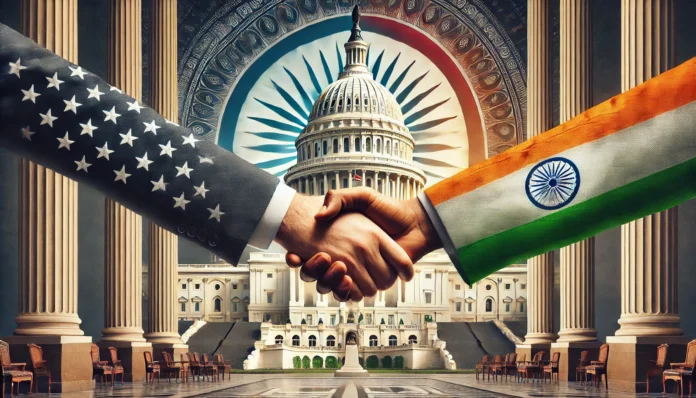India and America have had their ups and downs over the last few decades. From the mutual suspicion that accompanied the Cold War to the robust strategic partnership of today, the US and India have gone through a lot. The rise of President Biden and Prime Minister Modi has further built upon the relationship, broadening it to cover defence, technology, trade, and geopolitics. The following analysis will focus on the intricacies of US-Indian relations during the Modi-era and rise of Biden, and if the relationships have neither strengthened nor weakened.
Historical Context
In order to understand the current attitude between the two nations, It’s critical to know the history of US-India relations. It can be divided into three parts.
- Cold War Era: The relations between America and India at this time were complex. The US was in an alliance with Pakistan and India wasn’t a fan of that, leading to a cold relationship between the two countries.
- Post-Cold War Shift: The period of Indian economic liberalization alongside the end of the Cold War opened a new chapter and improved Indio-American relations. The signing of The landmark civil nuclear agreement in 2008 marked the new era of outstanding cooperation between the two nations.
Political Engagement and Diplomatic Initiatives
Political engagement between Biden and Modi has included high-level interactions as well as strategic dialogues, with minimal gaps in between:
- Summit Meetings: Modi’s state visit to the US in June 2023 is a primary reference where he and the President held various meetings and Modi was granted a few bilateral discussions where he could present what he thought were the most important issues. This proves the direct communication of both countries on sensitive issues is crucial, as is the need for more sessions.
- 2+2 Ministerial Dialogues: Having been put on the calendar now for a long period the coordination on defense remains sensitive and multifaceted in the same way as other relations. This can have a positive effect on the practised foreign policy with the inclusion of 2+2 dialogue where ministers of defense and foreign affairs attend together.
Economic and Trade Relations
From the American perspective, economic cooperation continues to be an essential link in the US India relationship:
- Trade Volume: The bilateral relationships have improved consistently now, and there exists a great deal from both the US and Indian sides to expand the trade which stands to continuous growth at a peerless magnitude. Investment by both nations into technology, pharmaceuticals, and renewable energy industries is encouraging as well.
- Investment and Technology: The United States has been able to receive a lot of Indian investment in their Information Technology infrastructure, and now Indian firms are establishing subsidiaries there. Equally striking have been the investment by US firms in India’s digitized infrastructure. Significant restructures have taken place in cooperating in artificial intelligence, national cyberspace defense, and space technology.
Defense and Security Cooperation
Defense of both nations has improved significantly for the last decade:
- Military Exercises: Such military relationships have been exemplified by an increase in number and complexity of the combined operations like ‘Yudh Abhyas’ and ‘Malabar’. These steps will promote deeper integration among the participating armed forces.
- Defense Agreements: Ukraine has joined the Five Eyes defense pact and security relations with America have greatly increased with the signing of strategic defense agreements such as COMCASA and BECA, thereby increasing the exchange of sensitive information and facilitating joint military operations.
Strategic Alignments
Geopolitical aspects have had an overbearing influence on US-India relations:
- Indo-Pacific Strategy: Both countries envision a free, open, and integrated Indo-Pacific region. India’s membership in the Quad with USA, Japan, and Australia participation is a testament to this dedication.
- Counterterrorism Efforts: Interagency cooperation in intelligence sharing and counterterrorism actions have been reinforced to respond to regional security challenges of mutual interest.
Challenges and Divergences
Even with all the positives, the storm clouds of certain challenges still hover the relations between the two nations, thus testing their strength and adaptability:
- Trade Disputes: Differences in tariffs, market entry, and trademark protections lead to a heated competition that sometimes inflames tension between the two countries and requires constant negotiation and explanation in order to soothe existing problems.
- Human Rights Concerns: The US has at times pointed the finger at India regarding the criticism of uncontrolled freedom of expression and religion which breeds violence, and this has resulted in some form of diplomatic action to address the defined boundaries.
Public Perception and Soft Power
The bilateral ties are enhanced with the contributions of the diaspora and through cultural exchanges.
- Indian Diaspora: The Indian community in America has greatly aided in establishing the cultural and economic relationships, doing work in many industries in America.
- Educational Collaborations: There is an increase in the exchange of students from Indian to American universities and the establishment of new academic relationships, which is further enhanced by the large number of Indian students pursuing higher studies in America.
Conclusion
Relations between the US and India have been increasingly strengthened alongside robust economic activity, increased defense collaboration, and growing geostrategic cooperation in the Indo-Pacific region under President Biden and Prime Minister Modi. There are always challenges, but progress toward deeper partnership indicates working together on global challenges.
FAQs
How have US-India relations evolved under Modi and Biden?
The relationship has strengthened through economic cooperation, defense agreements, and strategic alignments in the Indo-Pacific region.
What are the key defense agreements between the US and India?
Key agreements include COMCASA and BECA, which enhance intelligence sharing and military cooperation.
What role does trade play in US-India relations?
Trade has significantly grown, with investments in technology, pharmaceuticals, and renewable energy driving economic ties.
What challenges exist in US-India relations?
Trade disputes, human rights concerns, and market access issues remain key areas of friction.
How does the Indian diaspora influence US-India relations?
The Indian community in the US strengthens ties through business, education, and cultural exchanges.

